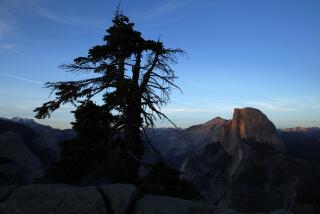A Fascination With Rock-Climbing
- Share via
After his eight-day ascent of Yosemite’s El Capitan, paraplegic Mark Wellman said he made the climb just because it was something he wanted to do. If it inspired other handicapped people, so much the better. As for his climbing partner, Mike Corbett was not overly concerned with his athlete’s image. When Corbett was asked to recall his scariest moment, the pack-a-day smoker said it was when his carton of cigarettes almost fell off a ledge. Two thousand feet up El Capitan is not the place for nicotine withdrawal.
The nationwide attention the climb received is just one manifestation of a growing fascination with rock-climbing in this country. Thousands of young men and women are establishing incredibly difficult new climbing routes in places like Smith Rocks in Oregon, Vedauwoo in Wyoming, the New River Gorge of West Virginia and even throughout the South. One of the nation’s top woman climbers lives in Atlanta.
For years, traditionalists claimed that publicity and competition were at odds with the notion that a virtuous mountain experience was two or three rumpled companions toiling up a remote virgin peak unknown to anyone. The only notoriety might come months later with a cryptic note in a climbing journal. But today, even the American Alpine Club supports climbing contests. A second annual international climbing meet will be held on an artificial climbing wall at Snowbird in Utah this summer. There will be television coverage, of course. If the truth were known, there always has been some form of competition: Climbers in the old days tried to keep their plans secret so they could beat their rivals to a coveted first ascent.
Still, the hoopla is nothing compared to what it has been in Europe for decades. If it were, there also would have been intense television coverage of the weeklong Paul Piana-Todd Skinner ascent of the Salathe Wall on the same side of El Capitan last summer. They did what the best climbers had tried and failed to do for more than a decade: make the first free ascent of perhaps the best and most sustained rock climb in the world. This means they climbed the 3,500-foot route without using their ropes and climbing gear except to hold them in the event of a fall. When the Salathe was first done during a 9 1/2-day stretch in 1961, Royal Robbins, Chuck Pratt and Tom Frost could surmount many hundreds of feet of vertical and overhanging wall only by standing in nylon loops clipped to pitons hammered successively higher into cracks in the Yosemite granite. Piana and Skinner did pitch after pitch of sustained free climbing at levels of difficulty that were not believed possible in 1961.
Another hot climber, Peter Croft, has done six classic Yosemite routes in a single day--routes that required a cumulative 10 days by the accomplished climbers who made the first ascents in the 1950s and 1960s. Croft did them alone without a rope for protection against falls.
There are many reasons for such achievements. They include the evolution of quality lightweight climbing gear, shoes with super sticky rubber, access to good rock for long stretches of time, diets, training and specialization in certain types of climbs.
The ultimate frontier of climbing, however, is the frontier of the mind. The Piana-Skinner climb was stunning, but they had the advantage of several weeks of practice on the route in advance, working out the moves needed to overcome many of the hardest obstacles. When Robbins, Pratt and Frost first climbed the Salathe, no one had been there before.
The unknown always has been a central element in climbing. As a specialized branch of mountaineering, competitive rock-climbing has evolved into a technical sport stripped of mystery and adventure. Some might think the same of Wellman’s climb of El Capitan as he hauled himself by brute arm strength up a route that had been climbed many times before. But what a frontier of the mind Wellman had to cross first.
More to Read
Sign up for The Wild
We’ll help you find the best places to hike, bike and run, as well as the perfect silent spots for meditation and yoga.
You may occasionally receive promotional content from the Los Angeles Times.






